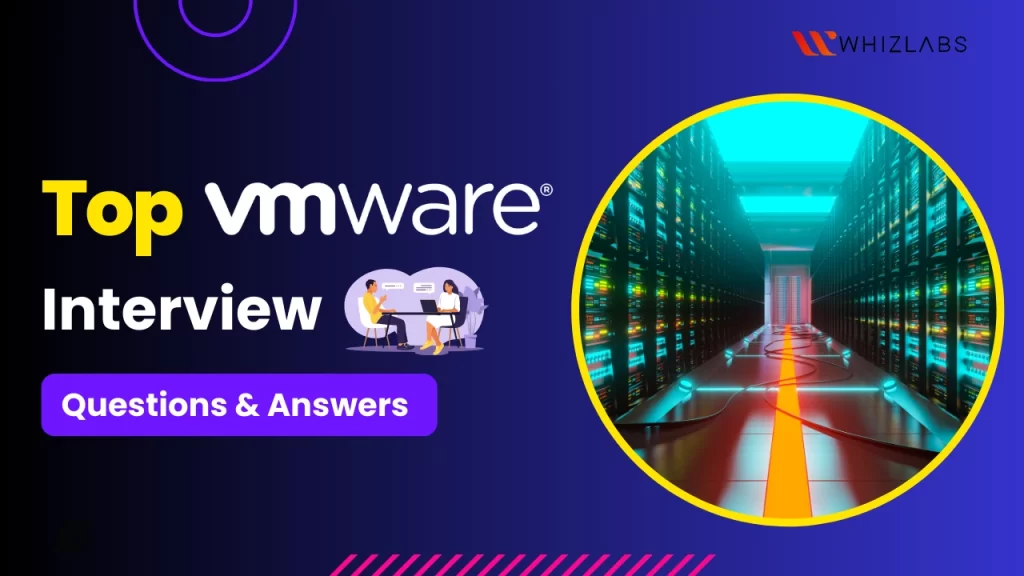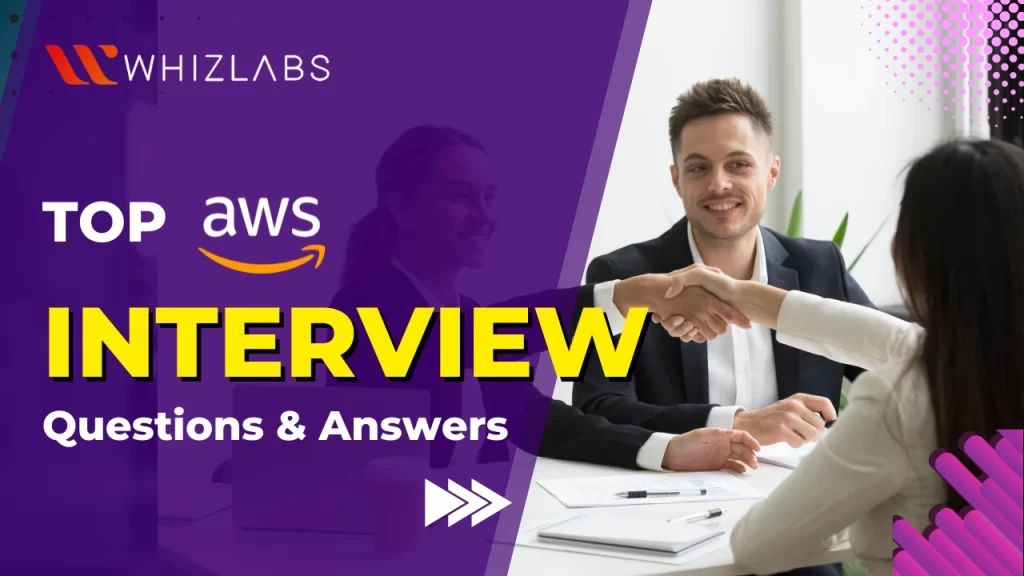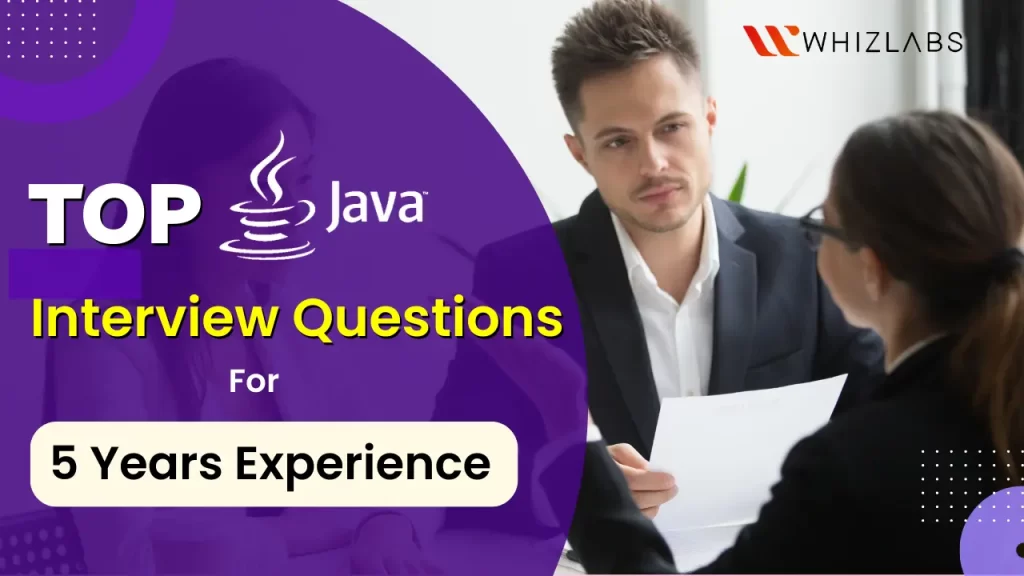VMware is a prominent multinational corporation that provides a wide range of cloud computing solutions. With a global presence and a strong reputation, it attracts top-tier candidates who seek a prestigious work environment.
Pursuing a career at VMware is undeniably promising for your professional aspirations. However, conducting a VMware interview can be quite challenging.
To aid in your preparation, here we have crafted VMware interview questions and answers designed to assist you in succeeding in your interview.
Let’s dive in!
Top 15+ VMWare Interview Questions and Answers 2024
Here are some frequently asked VMware interview questions and answers designed to bolster your confidence and assist you in securing your desired job during your upcoming interview.
1. What is a Virtual Machine?
VMware has the applications and software to do the virtualization process. VMware products have been categorized into two levels such as desktop applications, and Server applications.
Here are some core benefits of VMWare:
- You can run multiple operating systems as well as applications on a single desktop computer
- You can be able to control the hardware to increase productivity with the help of a few servers
- It simplifies processes such as IT management and increases the new application deployment process
- You can save up to 50% or more of your cost spent on the Information Technology2
2. What is a Type 2 hypervisor?
A Type 2 hypervisor is a software-based virtualization solution that operates within an existing operating system (OS), which itself runs on the physical hardware of a computer. This kind of hypervisor is commonly employed to allow a personal computer to run multiple operating systems concurrently. For example, it enables users to switch between running Windows or Linux on the same machine.
3. Which is faster Type 1 or Type 2 hypervisor?
It has been found that Type 1 hypervisors offer better performance than Type 2 hypervisors. The reason for the statement is that overhead associated with a host operating system in Type 1 does not affect the application performance and it is more secure.
4. What are the different types of Virtualization?
Virtualization type has been categorized into 6 types and they are:
- Application Virtualization: Access applications remotely while the server stores their data, useful for running different software versions. Technologies include hosted and packaged applications.
- Network Virtualization: Run multiple isolated virtual networks on a shared physical network, managed individually for confidentiality. Facilitates the creation of virtual networks, switches, routers, firewalls, VPNs, and security.
- Desktop Virtualization: Store the user’s OS on a server, granting access from any location using various machines. Key benefits: user mobility, and easy software management.
- Storage Virtualization: A system of servers managed by virtual storage, allowing seamless utilization and management of diverse storage sources as one repository. Ensures smooth operations and consistent performance.
- Server Virtualization: Central servers are divided into multiple virtual servers, boosting performance and reducing costs through resource allocation. Ideal for virtual migration and energy efficiency.
- Data Virtualization: Centralizes data from various sources, arranging it logically for remote access through cloud services. Offered by companies like Oracle, IBM, and Cdata.
5. What do you know about Hypervisors? and their types?
The hypervisor is a software component responsible for managing multiple virtual machines on a computer. Its role is to ensure that each virtual machine receives its allocated resources and operates without causing disruptions to other virtual machines. There are two primary categories of hypervisors:
Type 1 Hypervisor (Bare-Metal Hypervisor):
A type 1 hypervisor is installed directly on the computer’s hardware, bypassing the need for an underlying operating system. This direct installation leads to enhanced performance, making type 1 hypervisors a popular choice for enterprise applications. An example is KVM, which uses a type 1 hypervisor to host multiple virtual machines on the Linux operating system.
Type 2 Hypervisor (Hosted Hypervisor):
Also known as a hosted hypervisor, the type 2 hypervisor is installed on top of an existing operating system. Type 2 hypervisors are more suitable for end-user computing environments.
6. What is a Cluster in VMware?
A cluster refers to a group of hosts. Whenever a host is added to a cluster, the host resources become an essential part of the resources in a cluster. The cluster takes control of all the resources of the hosts. Clusters help to enable, vSphere High Availability (HA), vSphere Distributed Resource Scheduler (DRS), and VMware vSAN features.
7. What is meant by VMware snapshots?
A VMware snapshot is a copy of a virtual machine (VM) in a VMware environment taken at a specific point in time. Snapshots are useful for restoring a VM to a certain point in the event of a system failure or error. They are not useful for taking VM backups.
8. Is VMware a PAAS or IaaS?
Virtual Machines (VMs) fall under the category of Infrastructure as a Service (IaaS). This is because VMs grant you control over the operations and software within the virtual environment. On the other hand, Platform as a Service (PaaS) is designed to assist in managing the software running in the cloud, such as application services.
9. What is VMware NSX used for?
VMware NSX is a family of virtual networking and security software products that originated from the combination of VMware’s vCloud Networking and Security (vCNS) and Nicira’s Network Virtualization Platform (NVP) intellectual property. NSX, which stands for software-defined networking (SDN), is a fundamental component of VMware’s vision for a software-defined data center (SDDC), enabling cloud computing through VMware’s virtualization technologies. VMware’s objective with NSX is to create virtual networking environments seamlessly, eliminating the need for direct administrator intervention or reliance on command-line interfaces (CLI).
10. Explain VMKernel and its importance
VMware refers to operating systems with high performance and it runs directly on ESXi host. It acts as an interface between system physical hardware and VM and it is commonly referred to as a microkernel by VMware as it can run on bare metal and VMware ESX hosts directly.
In addition, it offers hardware abstraction and OS services, memory allocation, and CPU scheduling. Also, it handles services such as vMotion, NFS, iSCSI, and fault tolerance. To communicate Virtual machines with ESXi, the installation of the VMkernel is significant.
Also Read : Free Questions on VMware Certified Technical Associate [VCTA-DCV]
11. What is the use of vMotion?
vMotion allows you to:
- Migrate multiple virtual machines that run on any operating system across any type of hardware and storage aided by vSphere
- Identify the optimal placement for VM within seconds.
12. What is Promiscuous mode?
Promiscuous mode represents an operational state in which a network adapter captures all network traffic, without discriminating based on destination MAC or IP addresses. In the context of a virtual machine environment, enabling promiscuous mode for a guest virtual machine endows its virtual network interface card (NIC) with the ability to receive a duplicate copy of all data circulating within its assigned LAN or VLANs.
13. What are vSS and vDS?
vSphere Standard Switch, or vSS, is the default virtual switch that comes pre-installed on the ESXi host. It’s configured with a management kernel port and serves as a bridge for internal traffic between virtual machines within the same VLAN. Additionally, it connects to external networks via uplink ports to ensure network connectivity. The catch is that each ESXi host has its independent vSS, which means you must manage each one separately on every host.
On the other hand, we have the Virtual Distributed Switch, or VDS, which is an advanced version of the virtual switch. VDS offers the convenience of central management from the vCenter server. It’s distributed in nature, meaning you configure it once and then apply it to ESXi hosts, which inherit the associated settings. Any changes made to networking configurations within VDS through the vCenter Server are automatically propagated to all hosts.
14. What is the difference between ESX and ESXi?
| Aspect | ESX | ESXi |
| Architecture | Runs on a Linux-based console OS. | Utilizes the VMkernel hypervisor, known for enhanced security and reliability. |
| Operational Management | Managed through the Service Console. | Managed through vSphere Client and the web client. |
| Command-line Management | Uses ‘esxcfg’ commands. | Uses ‘esxcli’ commands. |
| Installation and Configuration | Installation can be slow and less intuitive. | Faster and easier installation and setup. |
| Code Patches | Code patches depend on the underlying Linux OS. | Requires fewer patches. |
| Footprint | Has a larger footprint. | Smaller, with just 150MB. |
| Management Overhead | Management overhead from third-party agents. | Eliminates overhead by employing APIs. |
| Troubleshooting | Troubleshooting through the Service Console. | Troubleshooting through the ESXi Shell. |
| Syslog | Doesn’t support Syslog. | Supports syslog. |
| Lockdown Mode | Doesn’t support Lockdown mode. | Supports Lockdown mode. |
| vSphere Access | Primarily for experimental purposes. | Complete management capabilities. |
| Hardware Monitoring | Relies on third-party agents. | Uses CIM providers for hardware monitoring. |
| Create Customized Image | Doesn’t support creating customized images. | Supports creating customized images. |
| VMkernel Network Apps | Connects to storage, vMotion, and fault tolerance. | Connects to storage, fault tolerance, network management, and ISCSI port binding. |
15. What is the latest ESXi version?
ESXi’s latest available version is ESXi 7.0. Licensing for ESXi hosts is tied to vSphere licenses, with each vSphere license specifying the capacity for licensing multiple physical CPUs on ESXi hosts. In the case of vSphere 7.0, a single CPU license is valid for up to 32 cores.
16. What is VMSphere?
VMware vSphere harnesses the capabilities of virtualization to streamline data centers, converting them into efficient cloud computing platforms. This empowers IT organizations to provide adaptable and dependable IT services. The foundational elements of vSphere consist of VMware ESXi and VMware vCenter Server.
17. What are the products of VMWare?
VMware offers a range of tools across different segments. These include:
- vSphere
- NSX-T Data Center (previously known as NSX-T)
- vSAN
- vRealize for virtualizing data centers
- For desktop virtualization, VMware provides the VMware Horizon Suite and Workspace ONE UEM
18. What is VMware DRS?
VMware DRS stands for Distributed Resource Scheduler and it helps to balance the resources across various hosts in a dynamic manner under resource pool. It helps the users to find out the rules and policies that decide how virtual machines can be able to deploy resources, and multiple virtual machines must prioritize these resources.
19. Define Port-group.
A port group is an integral component of a vSwitch and can be configured with distinct policies, such as shaping, security, and teaming. Additionally, it can be associated with a particular VLAN. Each port group is distinguished by a network label that is exclusive to the host it’s on. Every member within a port group adheres to shared characteristics, including a common VLAN tag.
20. Explain cold and hot migration.
In a cold migration, a Virtual Machine is turned off, and then it’s moved to a different physical host or data store. The VM’s power is OFF, and it doesn’t require shared storage. This method doesn’t involve checking the CPU, and it can take a while. Log and configuration files are transferred from the original host to the new one.
Once the VM is on the new host, it’s powered on. Any applications and the operating system are stopped before the move, and the user can decide whether to move the associated disks to a different data store.
In a hot migration, a Virtual Machine that’s already powered on is moved from one physical host to another. The state of the original host is cloned to the destination host and then discarded on the source host. The complete state of the VM is transferred to the new host. This method requires shared storage and involves CPU checks. It’s relatively fast, with minimal downtime.
There’s no need to stop the operating system or applications; they seamlessly shift from the virtual to the physical machine. This approach allows for freeing up physical servers for maintenance and balancing workloads for optimal performance among physical servers. Clients can continue without significant interruptions.
Conclusion
Hope we have listed out some of the most commonly asked VMware interview questions and answers for experienced and beginners in this blog article. However, it’s important to note that VMware is a highly extensive technology. If you require more questions or further clarification, you can explore the VMware Knowledge Base for additional information.
Whizlabs offers hands-on labs and sandboxes for individuals to explore the tools and functionalities of their platform.
Before facing VMware-related questions in an interview, it’s advisable to utilize this resource to become familiar with all of VMware’s functions and features.
Best of Luck!
- Top 20 Questions To Prepare For Certified Kubernetes Administrator Exam - August 16, 2024
- 10 AWS Services to Master for the AWS Developer Associate Exam - August 14, 2024
- Exam Tips for AWS Machine Learning Specialty Certification - August 7, 2024
- Best 15+ AWS Developer Associate hands-on labs in 2024 - July 24, 2024
- Containers vs Virtual Machines: Differences You Should Know - June 24, 2024
- Databricks Launched World’s Most Capable Large Language Model (LLM) - April 26, 2024
- What are the storage options available in Microsoft Azure? - March 14, 2024
- User’s Guide to Getting Started with Google Kubernetes Engine - March 1, 2024



